Chaetachme aristata
Chaetachme aristata Planch.
Family: Cannabaceae
Common names: thorny elm (Eng.); doringolm, basterwitpeer (Afr.); mula-nguluvhe, muthavhalunzhi (Tshivenda); umbhangbangwe, umkaboti (isiZulu); umkaboti, umkhovothi (isiXhoza)
SA Tree No: 43
Introduction
Chaetachme aristata is a fascinating tree species, commonly found across the eastern regions of southern Africa and in tropical Africa and Madagascar. Often referred to as the thorny elm, its glossy leaves, thorny branches and its size make it stand out in its native habitats. The tree is well-adapted to survive in environments such as riverbanks and bushveld regions, where its resilient structure allows it to thrive. It plays a vital ecological role in its ecosystem, providing habitat and food for wildlife. Its fruit and leaves are a significant resource for birds and mammals, while its wood, though dense and tough, has traditional uses.
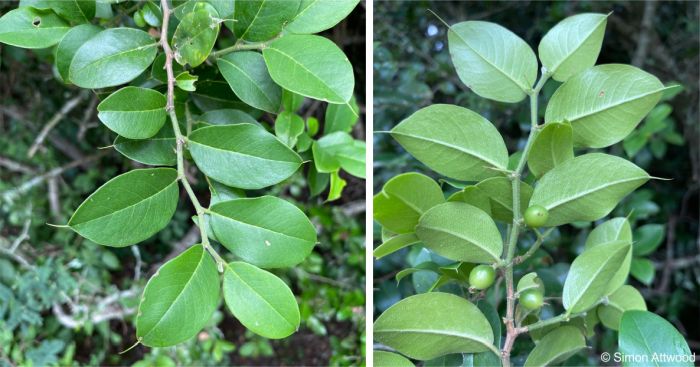
Description
Description
Chaetachme aristata is a medium to large tree, often characterized by its sprawling, bushy growth habit. It can grow as dense spiny shrub or a tree up to 15 m tall, although it typically reaches heights of around 10-12 m in more challenging environments. The bark of the tree is pale grey and smooth, lending the tree a refined, yet rugged appearance. Its branches are equipped with tough, sharp spines, which offer protection from herbivores and add to the tree’s defensive nature. The leaves of Chaetachme aristata are thick, leathery, and glossy. They are arranged alternately on the branches and are dark green, rounded to egg-shaped, with a blunt point crowned with a thin bristle. The leaves are hairless, further contributing to the tree’s smooth appearance. The tree’s branches often exhibit a zigzag pattern, with thorns occurring in pairs or singly along the shoots.
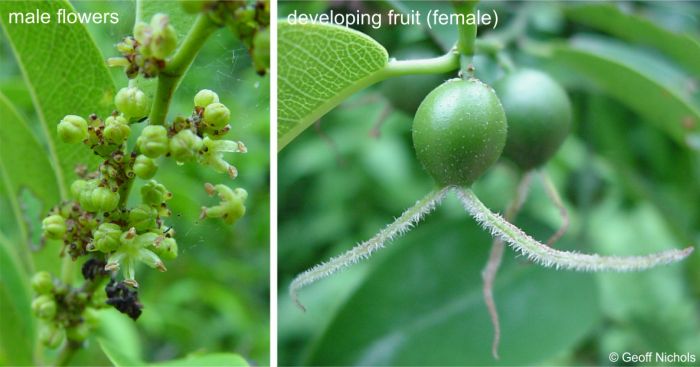
During the flowering season, typically in early summer, between October and December, Chaetachme aristata produces small, inconspicuous greenish flowers. These flowers are unisexual, meaning that they are either male or female. The male flowers appear in clusters, while the female flowers are solitary. Both are found on the same tree. The fruit of the tree is a drupe, round and thin-fleshed, with a colour ranging from pinkish-yellow to orange when ripe. The drupes measure approximately 15 mm in diameter and ripen from December to November. These fruits are an important food source for many bird species, including thick-billed weavers, as well as small mammals such as bats.
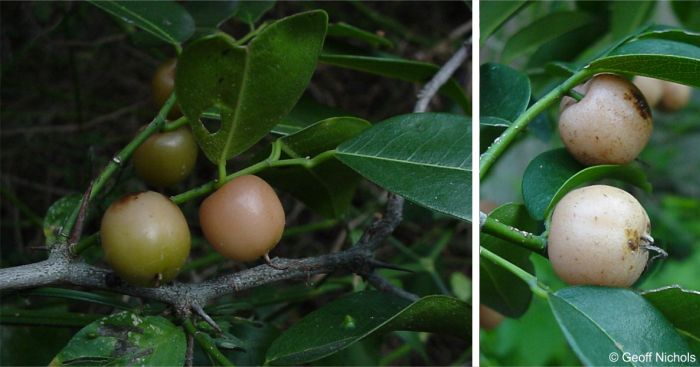
Conservation Status
Status
According to SANBI Red List of South African Plants, Chaetachme aristata is listed as a species of Least Concern (LC). This classification reflects the tree's widespread distribution and stable population numbers across its range. There are no significant threats currently affecting its population, though habitat destruction in certain areas could potentially pose future risks. Conservation efforts focus on maintaining the tree's natural habitats, especially along riverbanks and forest edges, where it thrives.
Distribution and habitat
Distribution description
Chaetachme aristata is distributed across several regions in Africa. In South Africa, it can be found in the provinces of the Eastern Cape, Gauteng, KwaZulu-Natal, Limpopo, Mpumalanga, North West and Western Cape, particularly around Knysna. Its distribution, however, is not limited to South Africa. The tree also occurs in Eswatini, southern and central Mozambique, parts of West Africa, Sudan, and even as far as Madagascar. Its ability to adapt to different environmental conditions contributes to its widespread distribution.
This species thrives in riparian habitats, which are ecosystems located along rivers and streams. It is often found along floodplains, riverbanks, and the edges of forests. These areas provide the moisture and nutrients the tree requires to grow successfully. The tree can also be found in coastal wooded grasslands and bushveld, where it forms part of the understory in more open woodland areas. The preference for moist environments enables Chaetachme aristata to withstand occasional flooding and seasonal changes in water availability.
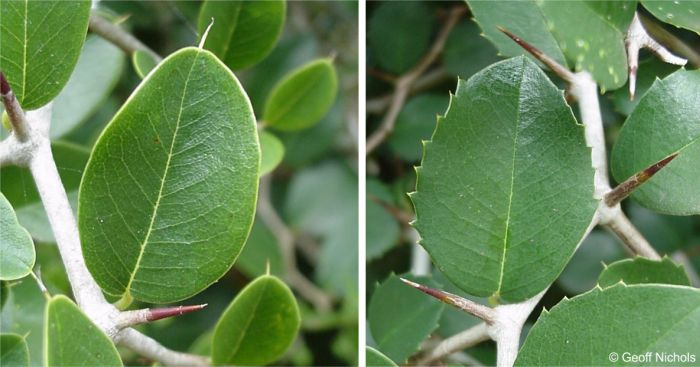
Derivation of name and historical aspects
History
The scientific name Chaetachme aristata has an interesting etymology. The genus name Chaetachme is derived from the Greek words chaeta, meaning ‘bristle’, and achme, meaning ‘point’ or ‘edge’. This refers to the bristle-like tips of the leaves, a distinguishing feature of this species. The specific epithet aristata comes from the Latin arista, meaning ‘awn’ or ‘bristle’, and -atus, meaning ‘provided with’. This name also describe the bristle-tipped leaves of this tree.
Chaetachme aristata belongs to the Cannabaceae (hemp family), a group of flowering plants including Cannabis (hemp), Humulus (hops) Celtis (white stinkwood) and Trema (pigeon wood), which includes plants that are often dioecious (male and female plants) with reduced flowers often pollinated by wind and is made up of herbs and trees. In the past, this species was classified under the Ulmaceae (elm family) and Celtidaceae (celtis family). In the older, pre 1990s, classification systems, plants in this group were placed under the Urticales (the nettles) however, DNA studies showed that they belong with the Rosales.
Historically, Chaetachme aristata has been recognized by various indigenous communities for its medicinal properties and its usefulness as a source of hard, durable wood. Though not as widely used today in modern industries, it holds cultural significance and has been utilized in traditional craftsmanship.
Ecology
Ecology
Ecologically, Chaetachme aristata plays a crucial role in the ecosystems it inhabits. As a riparian species, it contributes to the stability of riverbanks and floodplains, preventing soil erosion and maintaining the integrity of these habitats. The tree’s dense foliage provides shelter for various animals, including small mammals and birds, while the thorny branches offer protection from predators.
The leaves of Chaetachme aristata are a favoured food source for certain herbivores, particularly large browsers such as antelope and black rhinoceroses. These animals help in seed dispersal, as they feed on the fruit and inadvertently transport the seeds to new areas through their droppings. This interaction between the tree and local wildlife ensures the tree’s continued survival and helps maintain the balance of the ecosystem.
The tree’s fruit is especially important for bird species. Many birds, including thick-billed weavers, rely on the fruit as a source of nutrition during the dry season. Bats also consume the fruit, further aiding in seed dispersal. This mutualistic relationship between the tree and the animal in its environment highlights the ecological importance of Chaetachme aristata.
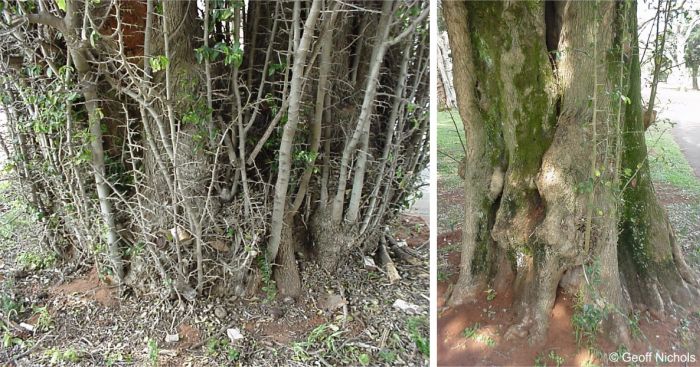
Uses
Use
Chaetachme aristata has been used for a variety of purposes by indigenous peoples, particularly in traditional medicine and crafting. The Zulu people, for example, use the bark of the tree to treat haemorrhoids, while the powdered roots are employed as a remedy for toothache. These traditional medicinal uses reflect the long-standing relationship between local communities and the natural environment.
The wood of Chaetachme aristata is dense, hard, and highly durable, making it valuable for crafting sturdy objects. However, its toughness also makes it difficult to work, which limits its common use in commercial applications. Nonetheless, the wood has been traditionally used to make tool handles, fighting sticks and musical instruments such as guitars. Some artisans carve small ornaments from the wood. Although not commonly used for large-scale timber production, the tree’s role in traditional craftsmanship and medicine highlights its cultural significance, particularly among the communities that live in the regions where it grows.
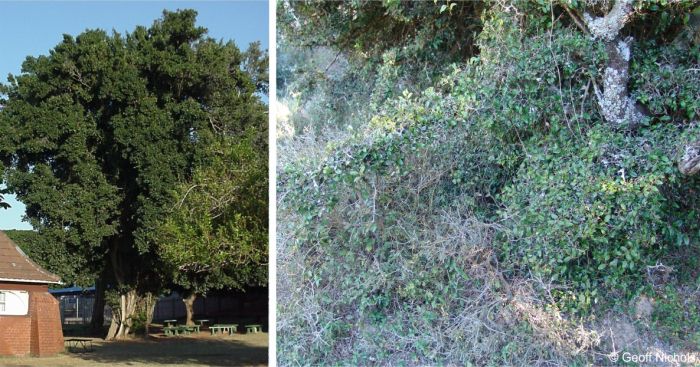
Growing Chaetachme aristata
Grow
Cultivating Chaetachme aristata can be challenging due to its specific environmental requirements, but it is not impossible for those willing to provide the right conditions. The tree prefers moist, well-drained soils and thrives in riparian zones where water is abundant. It can be propagated from seeds, although germination can be slow and requires careful management of water and temperature.
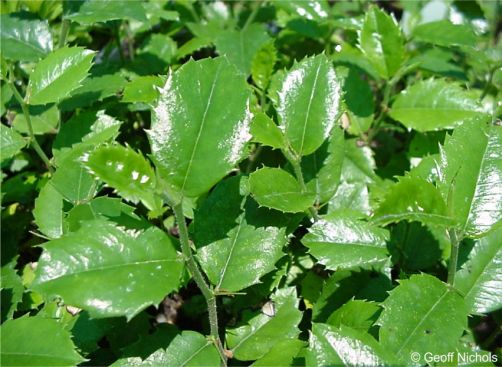
When propagating from seed, it is essential to collect the fruit once it is ripe, usually between December and November. The seeds should be cleaned and treated to encourage germination, as the fruit contains compounds that may inhibit the process. The fleshy outer layer is hard and difficult to remove. Nichols recommends placing 30-50 fruits in a blender with a cup of water and press the button two or three times in 5-10 second bursts to chip off enough of the flesh to expose the seed and allow water in to start the germination process. Once the seedlings have emerged, they need to be kept in a humid environment with consistent watering to mimic the tree’s natural habitat.
In areas where the tree is planted for ornamental purposes or erosion control, it is important to maintain a moist environment and ensure the tree is not exposed to prolonged drought. Pruning may be necessary to control its size and shape, especially when grown in a garden setting.
Chaetachme aristata can be a valuable addition to gardens and landscapes, particularly in areas where water is readily available. Its dense foliage, thorny branches, and attractive fruit make it a unique tree with both aesthetic and ecological benefits.
References
- Attwood, S. 2024. Observation of Chaetachme aristata, Bivane Dam, KwaZulu-Natal. iNaturalist. Online. https://www.inaturalist.org/observations/201965612.
- Burrows, J., Burrows, S., Lotter, M. & Schmidt, E. 2018. Trees and shrubs of Mozambique. Print Matters Heritage
- Codd, L.E.W., Dyer, R.A., Rycroft, H.B. & Winter, B.D. 1963. Flora of Southern Africa: the Republic of South Africa, Basutoland, Swaziland and South West Africa. Government Printer. Pretoria.
- Launert, E., Bell, E.A., Mendes, E.J. 1985. Flora Zambesiaca: Mozambique, Malawi, Zambia, Zimbabwe, Botswana. Volume 7: Part 2. Royal Botanic Gardens. London.
- Nichols, G. 2005. Growing rare plants: a practical handbook on propagating the threatened plants of southern Africa. Southern African Botanical Diversity Network Report No. 36.
- Palmer, E. & Pitman, N. 1972. Trees of southern Africa. Balkema, Cape Town.
- Plants of the World Online. Cannabaceae Martinov. https://powo.science.kew.org/taxon/urn:lsid:ipni.org:names:77126717-1. Accessed 16/10/24.
- Pooley, E. 1993. The complete field guide to trees of Natal, Zululand and Transkei. Natal Flora Publication Trust, Durban.
- Raimondo, D., Von Staden, L., Foden, W., Victor, J.E., Helme, N.A., Turner, R.C., Kamundi, D.A. & Manyama, P.A. (eds) 2009. Red list of South African plants. Strelitzia 25. South African National Biodiversity Institute, Pretoria.
- Watt, J.M. & Breyer-Brandwijk, M.G. 1962. The medicinal and poisonous plants of southern and eastern Africa , edn 2. Livingstone, Edinburgh & London.
- Wikipedia. Cannabaceae. https://en.wikipedia.org/wiki/Cannabaceae. Accessed 16/10/24.
Credits
Gugu Mkhabela & Mpho Mathalauga
Pretoria National Botanical Garden
October 2024
Acknowledgements: images by Geoff Nichols and Simon Attwood.
Plant Attributes:
Plant Type: Shrub, Tree
SA Distribution: Eastern Cape, Gauteng, KwaZulu-Natal, Limpopo, Mpumalanga, North West, Western Cape
Soil type: Sandy, Loam
Flowering season: Early Summer
PH:
Flower colour: Green
Aspect: Full Sun, Morning Sun (Semi Shade), Afternoon Sun (Semi Shade)
Gardening skill: Challenging
Special Features:
Horticultural zones









Rate this article
Article well written and informative
Rate this plant
Is this an interesting plant?
Login to add your Comment
Back to topNot registered yet? Click here to register.